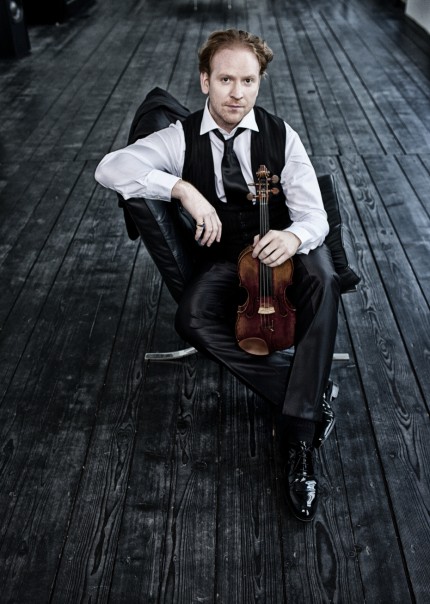Daniel Hope gives new life to composer’s updated Vivaldi

Violinist Daniel Hope performed music of Arvo Pärt and Max Richter in his Ravinia Festival debut Sunday night.
Sunday evening at Ravinia featured several new faces, with violinist Daniel Hope, conductor Tito Muñoz, and the Chicago Philharmonic all making their festival debuts in Highland Park.
The program featured three pieces by J.S. Bach, Arvo Pärt and Max Richter that illuminated one another by offering different views: the past, the present, and a contemporary fusion of the two.
The Four Seasons Recomposed was the clear high point of the evening. Composer Max Richter chose to retool Vivaldi’s masterwork in an attempt, said the British composer, “to rediscover it for myself and fall in love with it again, and to do that by charting a new route through Vivaldi’s landscape.”
Richter maintained the soul of Vivaldi’s pieces, while reworking them in a contemporary minimalist style. From the first measure of Spring it was clear that this was going to be a unique musical journey. The well-known, jubilant opening theme from Spring, familiar from cartoons to grocery stores, was stripped down to its basic motives and thrown into a seemingly timeless loop—still recognizable, but viewed from a completely new angle.
The slow movement in Winter was particularly striking. Richter took the gentle, comfortable central movement and put it in another cosmos with harmonics and cluster chords in the orchestra as the backdrop to the rhythmically free arrangement of the singing line.
In the final stormy movement of Summer, Richter maintained a great deal of the original material, his most prominent adjustment being a rhythmic one. By adding offbeat accents he created a more modern dance feel, breathing new life into the familiar.
Richter composed the piece for Hope, which was clear through the violinist’s rock-solid performance. He had clearly spent much time thinking about the material and was having fun with the music. Hope displayed dazzling virtuosity with a brilliant tone that had no difficulty projecting through the large space. There were passing moments when it felt like the Philharmonic was coming unraveled in the burst of fractured rhythms, but Muñoz kept them together and overall they performed well.
Hope was also heard in Arvo Pärt’s Fratres. The Estonian composer wrote the work in 1977, and throughout his career arranged Fratres. for different instrumental combinations. The incarnation performed Sunday was for violin, strings and percussion.
The wild introduction for solo violin consists of arpeggiated four-note chords over the four strings in a monumental crescendo that lasts almost a minute. The remainder of the piece offers repetitions of a solemn hymn theme representing the eight Office Hours devoted to prayers and psalm singing.
Hope performed with conviction, musicality, and understanding. His interpretation unfolded as a grand arch that linked the piece together, with each repetition building off the one preceding it in a clear direction. The conclusion with the violin playing in false harmonics, proved the highlight of Hope’s reading. Muñoz and the Philharmonic provided sensitive support, creating a pensive haze for the solo violin to ruminate within. The low strings provided a solid, consistent open-fifth drone and the rest of the ensemble played the slowly shifting harmonies with great balance and varied colors.
The evening got off to an uneven start with the Bach’s Brandenburg Concerto No. 3. The playing of the Chicago Philharmonic under Muñoz was mostly accurate and precise, with harpsichordist David Schrader performing the second movement solo with great sensitivity.
Still, the performance felt cautious, lacking the driving forward motion that is inherent to Bach. The Brandenburg rendering was also bound by acoustical issues, with the small baroque ensemble not projecting sufficiently in the large outdoor venue.
Posted Jul 30, 2013 at 11:17 am by David Lafferty
I much enjoyed Mr. Hope’s recording of the Richter-Vivaldi. At the same time I was reminded of the title of Vivaldi’s “Conflict of Harmony and Invention”. There is an intrinsic tension between the beauty of chords and timbre and the need to use those elements as mere steppingstones to structure. Minimalism and Spectralism exploit repetition and timbre, but somewhat at the expense of structure. By relying on increased volume and speed, these pieces often seem to merely “stop” instead of reaching a logical conclusion. Daniel Barenboim once wrote that he felt a sadness when a piece ended. I wanted the Richter-Vivaldi to go on, but I felt its conclusion was a “stopping” rather an inevitability.